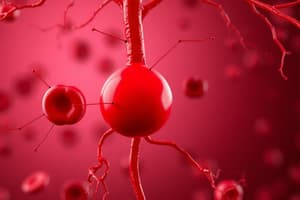Podcast
Questions and Answers
What is the normal range for Mean Corpuscular Volume (MCV)?
What is the normal range for Mean Corpuscular Volume (MCV)?
Which of the following classifications of anemia is characterized by reduced RBC production?
Which of the following classifications of anemia is characterized by reduced RBC production?
Which symptom is commonly associated with iron deficiency anemia?
Which symptom is commonly associated with iron deficiency anemia?
What is the best test to determine iron deficiency anemia?
What is the best test to determine iron deficiency anemia?
Signup and view all the answers
What is one of the most common causes of microcytic anemia?
What is one of the most common causes of microcytic anemia?
Signup and view all the answers
What does a high hemoglobin concentration indicate?
What does a high hemoglobin concentration indicate?
Signup and view all the answers
Which of the following is a characteristic feature of microcytic anemia?
Which of the following is a characteristic feature of microcytic anemia?
Signup and view all the answers
What is the primary clinical feature of sickle cell disease?
What is the primary clinical feature of sickle cell disease?
Signup and view all the answers
What laboratory finding is commonly associated with thrombocytopenia?
What laboratory finding is commonly associated with thrombocytopenia?
Signup and view all the answers
What is a common cause of secondary polycythemia?
What is a common cause of secondary polycythemia?
Signup and view all the answers
Study Notes
Learning Objectives
- Define complete blood count (CBC) and its importance in diagnosing hematological conditions.
- Classify anemias based on CBC results and indices.
- Identify general causes of microcytic anemia, including examples.
- Outline clinical and laboratory features of thalassemia.
- Classify normocytic anemias; provide examples for each.
- Classify macrocytic anemias, detailing clinical and laboratory features.
- Compare polycythemia vera with secondary polycythemia.
- Describe sickle cell disease, its underlying genetic abnormality, and clinical features.
- Explain glucose-6-phosphate dehydrogenase deficiency and its clinical implications.
- List four causes of thrombocytopenia.
- Describe clinical and laboratory features of idiopathic thrombocytopenic purpura (ITP) and thrombotic thrombocytopenic purpura (TTP), including treatment options.
Complete Blood Count (CBC) Basics
- Measures levels of hemoglobin, hematocrit, white blood cells, and platelets.
- Hemoglobin: Key protein in red blood cells that transports oxygen and carbon dioxide.
- Hematocrit: Percentage of blood volume comprised of red blood cells.
- White blood cell count and differential provide insights into immune system health.
- Platelet count assesses clotting ability.
- Terms:
- “Cytosis” indicates an excess (e.g., leukocytosis - high white blood cell count).
- “Penia” indicates a deficit (e.g., leukopenia - low white blood cell count).
Red Blood Cell Indices
- Mean Corpuscular Volume (MCV): Average size of red blood cells; normal range is 80-100 femtoliters. Microcytic if less than 80.
- Mean Concentration of Hemoglobin (MCH): Amount of hemoglobin per red blood cell; normal range is 27-31 picograms per cell. Hypochromic if less than 27.
Anemia Classifications
- Anemia: Reduction in the number of red blood cells (RBCs), hemoglobin, or hematocrit.
- Classification relies on red cell morphology and reticulocyte count, measuring bone marrow production of immature RBCs.
- Primary causes include decreased RBC production, increased destruction, or accelerated loss due to various conditions.
Microcytic Anemia
- Mnemonic TICS or TAILS helps remember causes:
- Iron deficiency (most common cause)
- Thalassemia
- Lead toxicity
Iron Deficiency Anemia (IDA)
- Characterized by hypochromic, microcytic red blood cells; can be normocytic normochromic early on.
- Symptoms include fatigue, restless leg syndrome, shortness of breath, exercise intolerance, weakness, and pica.
- Ferritin is the best diagnostic test for assessing iron storage and availability; levels above 50 ng/mL suggest no IDA.
Clinical Features and Laboratory Tests
- Anemia classification depends on cell appearance and reticulocyte count.
- Thalassemia presents with specific clinical features and laboratory findings distinguishable from iron deficiency anemia.
- Common causes of thrombocytopenia include immune disorders, bone marrow diseases, infections, and medications.
- ITP presents with petechiae and easy bruising whereas TTP causes microangiopathic hemolytic anemia and thrombocytopenia, requiring different treatment approaches.
Studying That Suits You
Use AI to generate personalized quizzes and flashcards to suit your learning preferences.
Related Documents
Description
Test your knowledge about the hematopoietic and lymphoid systems, focusing on complete blood counts, classifications of anemias, and clinical features of different types of anemia. This quiz will cover key definitions, general causes of microcytic anemia, and compare various anemia types. Be prepared to demonstrate your understanding of these crucial concepts.




